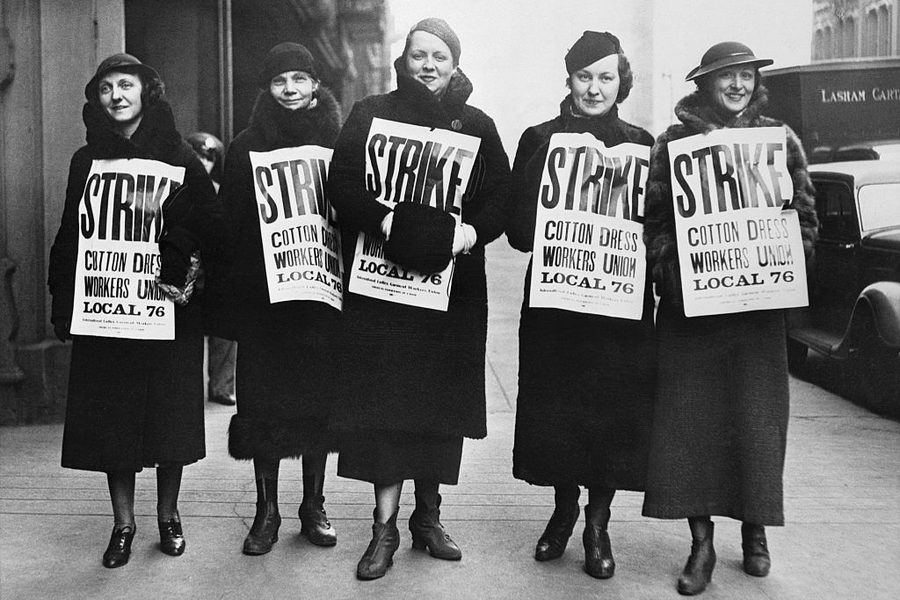
As this week’s Women’s Strike makes headlines, there’s a strange idea floating around the Internet: that striking is for the privileged, the province of well-off women with the luxury of being able to claim a vacation day or hire other people to take care of their children and loved ones.
In a country with a union density just south of 11 percent, there are a number of legitimate questions to be raised about the feasibility of a strike in 2017. Workers’ bargaining power stands at historic lows, and the institutions that once supported striking workers (namely, unions) have been eroded by a mix of neoliberal assault and market forces. Women, in particular — inordinately represented in low-wage service work — enjoy perilously few protections on the job, and are all too likely to face retaliation from their bosses for not showing up. Thanks to these and other structural factors, what happens will not be a truly mass strike. That’s why organizers have outlined a number of ways to plug into the day’s events, inside and outside the workplace.
Still, what’s troubling about an analysis that claims striking-as-privilege is its near-total disconnection from American labor history. Women’s strikes have never been about “abdicat[ing] parenting responsibilities in solidarity,” as Quartz’s Maureen Shaw put it — performing the role of a dutiful, privileged ally — but about recognizing a shared struggle across a workplace, industry, class or (in this case) country. Meghan Daum, at the Los Angeles Times, made an argument similar to Shaw’s but still more ill-informed: that women striking would somehow show that they are an accessory to the economy, instead of critical to its functioning.
“The idea that women should take a day off en masse to make a political point is both self-defeating and vaguely insulting. It’s meant to highlight how crucial we are, but its very premise also suggests the opposite: Women are expendable,” Daum writes, seemingly unaware of what a strike is. “‘A Day Without A Woman’ plays into the idea that we entered the workforce not to support ourselves and our families but to combat boredom or to boost our self-esteem. For all but a very few affluent women, that’s never been the case.”
As Magally A. Miranda Alcazar and Kate D. Griffiths explain at The Nation, poor and working women are no strangers to either strikes or mass actions, having been key forces behind everything from the movement for black lives to the “Day Without Immigrants.” Labor history is filled with women leaders like Dolores Huerta and Karen Lewis, who have been none too shy about using militant action to secure respect on the job and good contracts. More recently, women have populated picket lines in the Fight for $15 and outside Wal-Marts.
“Striking is not a privilege,” Alcazar and Griffiths conclude. “Privilege is not having to strike.”
In discussing the historical precedents for Wednesday’s strike, several writers have pointed to recent actions abroad — like those in Iceland and Poland — and a 1970 women’s strike for equality in the workplace, organized by America’s National Organization for Women. American history, however, is rife with examples of women striking as workers, at considerable risk to their lives and livelihoods. Following mining and the building trades, for instance, the textile industry — staffed almost entirely by women — was the third most strike-prone industry in the country in the early 20th century. Here are just a few examples of women who walked off the job:
Atlanta Washerwomen’s Strike, 1881
Less than 20 years after the end of the Civil War, half of Atlanta’s black wage earners were women, almost all doing domestic work for white households. Of those, many women were employed as laundresses, or “washerwomen,” to whom wealthy, middle class and even poor whites would send their dirty clothes. Washerwomen, including many former slaves, made between $4 to $8 a month for long hours of physically demanding labor.
In the summer of 1881, 20 washerwomen met and formed the Washing Society, comprised entirely of African American women. Canvassing fellow workers and garnering support from the city’s black churches, the Society’s ranks swelled from 20 to 3,000 laundresses in just three weeks. Strike meetings were held every night, and strikers faced arrests and harassment from police. Amid complaints from white families, the city charged women participating in the strike with “disorderly conduct and quarreling,” according to the Atlanta Constitution, and fined them sums greater than many of their monthly wages. A defendant in one such case was unable to pay, and sentenced to work for 40 days on a chain gang. The city also attempted to enforce a tax on any women found to be a party of the Washing Society. Anecdotal evidence suggests that the washerwomen’s strike also spread to other workers. As the Constitution reported at the time, “not only the washerwomen, but the cooks, house servants and nurses are asking increases.”
Eventually, the Society settled with the Atlanta City Council to pay a $25 annual licensing fee in exchange for higher rates and more autonomy. “We can afford to pay these licenses, and will do it before we will be defeated, and then we will have full control of the city’s washing at our own prices,” the women wrote in a statement to Mayor Jim English. The strike had a chilling effect on Atlanta’s white business and political establishment, unsure of whether the city could run without black labor. Shortly after the Washerwomen’s strike, Atlanta’s government caved to demands from cooks, maids, hotel workers and nurses for higher pay.
“The Uprising of 20,000” (1909)
New York’s Triangle Shirtwaist Factory is perhaps best remembered for the horrific fire that claimed the lives of 146 workers, most of them young immigrant women. Two years prior, however, many of the workers in that plant participated in what was one of the country’s biggest labor uprisings to date. In 1909, Yiddish-speaking women, many in their teens and early 20s, orchestrated an 11-week general strike across Gotham’s 600-shop shirtwaist industry, otherwise known as the “needle trades.” It all started with a spat of spontaneous strikes in the Leiserson Company, the Rosen Brothers and at Triangle, protesting workplace safety issues, low wages and rampant sexual harassment, among other issues. In conditions common throughout the industry, Triangle workers worked uninterrupted 14 hour shifts with just one bathroom break, forcing many to urinate on the factory floor.
Work actions, begun in the late summer and fall, carried on for several months before Local 25 of the International Ladies Garment Workers’ Union (ILGWU) began to question whether members should return to work. At a packed meeting to discuss the strike’s future, worker-organizer and Local 25 executive committee member Clara Lemlich made an impassioned call: “I am a working girl, one of those who are on strike against intolerable conditions. I am tired of listening to speakers who talk in general terms. What we are here to decide is whether we shall or shall not strike. I offer a resolution that a general strike be declared — now.” The resolution passed.
In the morning, 15,000 shirtwaist workers struck. Overall, 70 percent of strikers were women. Ninety percent were Jewish. More than 700 were arrested within just one month, 19 of whom were sentenced to the workhouse. Several faced beatings by police. As in other strikes, several of the most instrumental organizers were socialist women and immigrants, like Lemlich and Rose Schneiderman.
Eventually, strikers’ resources were exhausted and the uprising was called off — though not before winning significant concessions. The strike was also a boon for the ILGWU, which, by the end of the strike, counted some 85 percent of New York shirtwaist makers as members. Inspired by the events of 1909, similar strike actions followed, eventually rendering the textile industry one of the country’s most union-dense. Beyond those gains, the uprising further cemented women’s role in the to-that-point fairly conservative ILGWU, the leadership of which would be replaced by socialists in 1914.
Chicago Garment Workers Strike (1910)
By 1910, Chicago’s textile industry was its third largest employer, and its largest employer of working women. Beginning in late September with 16 women in the Hart, Schaffner and Marx plant—the largest clothing manufacturer in the nation at the time — the strike swelled to 2,000 workers in just the first week, including Yiddish, Czech, Polish, Italian, Lithuanian and English speakers. As in New York’s Uprising the year prior, many of the core organizers behind the strike were teenagers and socialists. Nellie M. Zeh, who helped organize picket lines in various Chicago neighborhoods, opined about the young women strikers in one of the city’s socialist papers: “Sweet and pretty is that laughing face, but strength of character is also shown in that it was she who took the lead in the walk-out of an entire shop.”
Per industry standard, working conditions in the plant were deplorable. What agitated workers into declaring a strike, though, was the imposition of a “bonus system,” whereby the piece rate per garment was cut and male supervisors were given more discretion over which workers did and didn’t get paid. An estimated 41,000 workers joined in once the strike was endorsed by the United Garment Workers (UGW), though Chicago organizers criticized the union for failing to call for a general, industry-wide strike. City residents rallied in support of striking workers, with doctors offering free medical care and theaters hosting benefit performances for the union’s strike fund. Chicago authorities were not as kind: City police and agents hired by the textile companies shot two striking workers dead, with three other Chicagoans killed as the result of stand-offs between workers and their employers.
A settlement with a majority of strikers was reached in December, though a number of strikers stayed off the job for several months after the UGW withdrew its support, demanding further concessions. The Chicago strike laid the groundwork for the creation of the Amalgamated Clothing Workers of America and launched the career of famed labor organizer Sidney Hillman.
Los Angeles Garment Workers Strike (1933)
In the wake of the Great Depression, Los Angeles dressmakers began a strike that would spread to an estimated 2,000 workers and 80 manufacturers. Textile employers routinely violated the city’s living wage ordinance, paying workers only for the time they spent cutting and sewing parcels of garments, which came in at odd intervals. Dressmakers worked on hot and poorly ventilated shop floors, and work was often irregular, with few guarantees of paid work on a given day.
Three-quarters of workers in the dressmaking industry were Mexican immigrants, who were also the main organizers behind the strike. They were part of the Los Angeles local of the ILGWU. To that point, Los Angeles’s textile industry had been hostile to unions, so establishing the local in the first place, in a proudly “open shop” town, was an achievement in its own right. What’s more, the union’s own white, East Coast leadership had been convinced that Mexican garment workers were “unorganizable.”
They were proven wrong. Organizing in both factories and neighborhoods, in English and in Spanish, rank and file activists began building toward a strike, with demands for union recognition, a 35-hour week, higher wages and other protections.
The three-week strike that ensued when employers refused workers’ demands ground the city’s textile industry to a halt. More than 3,000 workers turned out to a Garment District picket line on the strike’s first day. Tensions quickly swelled between strikers and their bosses, who called on the police to jail and intimidate their employees. One striker-turned-longtime labor organizer, Anita Andrade Castro, recalled being jailed 37 times, the first time for giving out leaflets. Manufacturers began caving after two weeks, and the ILGWU ended up winning several of its demands, including its central call for collective bargaining rights.
Kate Aronoff is a staff writer at The New Republic and author of Overheated: How Capitalism Broke the Planet — And How We Fight Back. She is co-author of A Planet To Win: Why We Need a Green New Deal and co-editor of We Own the Future: Democratic Socialism—American Style. Follow her on Twitter @katearonoff.








